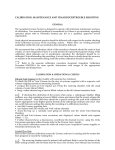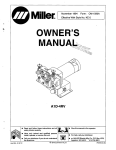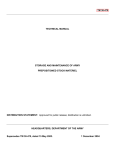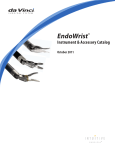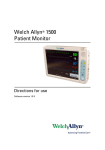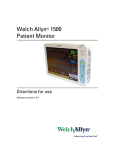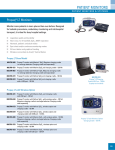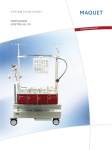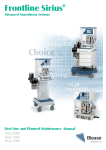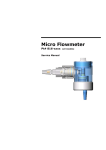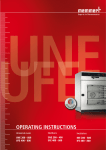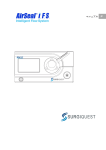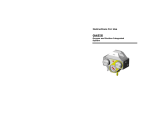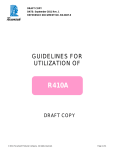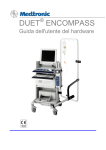Download Clinical Urodynamics Guide
Transcript
Clinical Urodynamics Guide Document No. NSO1875D Revised: 17.07.99 The purpose of this guide is not to describe the clinical reasons for urodynamic diagnostic testing, but to give a general outline of the mechanics of the test. The actual sequences and methods utilised may vary from lab to lab. References to equipment and their operation are clarified in later revisions. This document contains clinical diagrams for pressure transducer and catheter setup. Some diagrams are representations and may not accurately depict certain equipment. It is intended as a guide only. This document is under revision, some sections may not contain the latest information on some of our new products. Some procedures are under revision to include these new products, Please contact Neomedix Systems if you have any problems or suggestions regarding this document or require more detailed information for system setup Tel: Fax: eMail: netSite: +612 9913 8044 +612 9913 7818 [email protected] http://neomedix.com System Setup Clinical Urodynamics Guide Document NSO1875D 2 General Preparation Because of the many variations in testing procedures it is not possible to dictate any standard in patient preparation. Follow the normal procedures adopted by your department. Acquidata Ensure the system has been turned on for at least 10 minutes before a test to allow all components (mostly the pressure transducers) to thermally stabilise. acquiamplifier (top) & acquiprocessor (bottom) Transducers Fill volume: suspend the infusion bag, filled with the appropriate bladder filling solution, from the fill volume hook and position the delivery tubing such that it is not under tension. If a powered filling pump is used, the tubing from the infusion bag feeds to the inlet fitting on the pump tubeset. The tubeset output fitting is connected to the patient filling catheter. filling volume sensor Void volume and flow: ensure that the receiving chamber has a small amount of liquid in the bottom, which is enough to just cover the bottom of the central tube. Position the receiving chamber upon the holding platform and position it under the voiding commode. Attach the funnel splash cover for male use when not using the commode. The optional turbulence reducer plug may also be placed in the funnel when urine flow has a tendency to be focused directly above the funnels central area (this added kinetic energy can cause increased noise in the flow signal). receiving chamber Note: Some later models of the Uromac system may not use a holding platform and weighing transducer flow sensor System Setup Fluid filled pressure transducers: External fluid filled pressure transducers are much more robust than their earlier designs of 5-10 years ago, however, they are still a relatively sensitive item and must be treated accordingly. Active transducers warm up over the first 10 minutes after being turned on, the liquid in the dome also stabilises to the transducers operating temperature. Note: 1. Never wet the electrical connector. 2. Never steam autoclave a transducer Clinical Urodynamics Guide Document NSO1875D 3 1 mount MX848 sterilised disposable dome to MX860 transducer 2 attach transducer assembly on to mounting plate which is then attached to patient pole (not shown) System Setup Clinical Urodynamics Guide Document NSO1875D 4 Standard Fluid Filled Patient Catheters (FFC) Have prepared for connection a sterile pack of standard patient pressure and bladder filling catheters. These will be connected to the pressure transducers (and saline or water bag in the case of the filling catheter) after introduction into the patient. Note: For the sake of clarity of description the connection of the catheters to the transducers is given prior to the description of the ‘urodynamics test’. In practice, catheters are placed in the patient prior to transducer connection. These are supplied as kits: UD-001 with 14F UD-005 filling catheter, UD-004 vesical pressure catheter, UD-003 abdominal pressure catheter and two syringes. UD-002 with 10F UD-005 filling catheter, UD-004 vesical pressure catheter, UD-003 abdominal pressure catheter and two syringes. A UD-004 bladder pressure monitoring catheter B UD-003 abdominal pressure balloon catheter C UD-005 bladder filling catheter D MX634L 4-way stopcock • UD-005 in 14F size is supplied in kit UD-001 • UD-005 in 10F size is supplied in kit UD-002 • this page to be revised System Setup Clinical Urodynamics Guide Document NSO1875D 5 Preparation of fluid filled patient pressure channel Use normal sterile techniques and hospital protocols as appropriate for this procedure. Vesical (Bladder) channel 3 connect the vesical pressure catheter to this port on the transducer dome • Fill a syringe with sterile saline or water and connect it to the luer port of the vesical pressure transducer. • Connect the vesical pressure catheter to the other port of the vesical pressure transducer. Note: This is usually done after the catheter is introduced into the patient 2 attach 4-way stopcock this luer port of the transducer dome 1 fill syringe with sterile saline or water and connect to luer port of 4-way stopcock Clinical Urodynamics Guide Document NSO1875D 6 System Setup Vesical & Urethral pressure channels • The perfused liquid is supplied by the mechanical compression pump • Set up vesical transducer as previously shown. • Fill the 10mL or 30mL syringe with sterile water. • Set up the urethral transducer as for vesical channel but add the second 4-way stopcock to facilitate the addition of a pressurised perfused (low flow rate) liquid source to allow accurate measurements for the urethral sphincter pressure. • Operate the pump by turning to on the switch on the pump body until all the air has been flushed through the urethral catheter lumen and interconnect tube. • In operation the urethral lumen of the vesical / urethral multilumen catheter measure both pressure and passes the perfused liquid to the urethral pressure monitoring side eye in the catheter. Vesical Channel • Turn off the pump. Urethral Channel InfuPress mechanical compression pump Flowrate: constant 0.03mL/sec Volume: 10 or 30mL syringe Perfusate: Sterile water or saline. MX860 transducers employing replaceable sterile domes. 4-way stopcock utilised between dome and flushing syringe. Hydraulic resister tubing • this page to be revised System Setup Clinical Urodynamics Guide Document NSO1875D 7 Abdominal (Rectal) pressure channel • Fill a syringe with sterile saline and connect to a sterile 4 way stopcock which in turn is connected to the luer port on the transducer dome. • Flush through the transducer dome until all air is displaced. 3 connect the abdominal pressure catheter to this port on the transducer dome 2 attach 4-way stopcock this luer port of the transducer dome 1 fill syringe with sterile saline or water and connect to luer port of 4-way stopcock System Setup Clinical Urodynamics Guide Document NSO1875D 8 Alternative Micro Transducer Tipped Pressure Catheters (MTC) These devices can be used instead of the fluid filled catheter connected external transducers. They have the advantage of not requiring fluid filling, flushing or zero balancing when the patient is repositioned. Micro tipped transducers can be used with the Acquidata Uromac system directly. With care, these catheters will give long service provided the following handling precautions are followed meticulously. Special Considerations: A closeup view of a single sensor 5F - polyurethane MTC B view of a dual sensor 8F - polyurethane MTC • Do not 'kink' the catheter. • Do not coil the catheter into loops smaller than 20cm diameter. • Do not handle the sensing element. • When the transducer is not in use cover the sensing elements with the protective cover tube supplied, or store in the optionally supplied calibration burettes. A B • To sterilise the transducer follow the manufacturer instructions supplied with the catheter. Autoclaving will destroy the MTC devices. • Take care that the electrical connector end does not come in contact with liquids or corrosive gases. Standard units available for the Acquidata Uromac are: P5FU Vesical and Abdominal channels (single sensor 5F - polyurethane) and for predominately female urethral testing: 2P8FLU Vesical and Urethral channels (dual sensor 8F with filling lumen polyurethane) • this page to be revised Clinical Urodynamics Guide Document NSO1875D 9 System Setup Powered Vesical / Urethral Withdrawal withdrawal speed selector switch spring biased securing clip withdrawal unit UPP01 catheter guide catheter introduced into the bladder via the urethra prior to starting withdrawal operation adjustable arm footswitch cable to withdrawal unit power module I footswitch pads for insertion or withdrawal W • this page to be revised System Setup Electromyography (EMG) EMG Option The EMG option allows the recording of muscle activity to be recorded simultaneously with other urodynamic signals. The option comprises four items:• The EMG amplifier inherent within the AcquiAmplifier. • The active input patient headstage (NT462F). • An external audio amplifier and loudspeaker. • The patient leadwires and electrode kit. The EMG amplifier is a high gain device, different from those used for normal pressure and other transducer monitoring. For Urodynamic applications the output can be selected as the raw input signal or a integrated (200ms) envelope of the input signal. The amplifier has a fully isolated input stage for patient protection. EMG Range To select the desired sensitivity for an input signal range from 100 uV to 50 mV using the knob control on the extreme right/side of the AcquiAmplifier. For each selected range an input signal of the indicated range in amplitude will produce a full scale output of 1.0 Vpp. to the ADC in the AcquiProcessor. Volume A single turn control for adjustment of the EMG signal volume is available on the speaker supplied. During electrode or cable replacement, the speaker can be turned off to remove loud artifact noises. Optional EMG needle electrode (dual concentric bipolar) Clinical Urodynamics Guide Document NSO1875D 10 Operating Procedure • Connect the audio output to the remote speaker. • Connect the patient electrode and interconnect with the leadwires connectors to the active head stage input (NT462F). • Select the range switch to a suitable setting which, in most cases, will be approximately 1mV or greater sensitivity. Monitor the quality of the audio signal aurally until the recording electrodes are correctly positioned and recording the urethral electromyographic activity synchronous with patient voiding. • Select 'Integrated' EMG using the rear panel switch on the AcquiAmplifier. This optional integrated EMG will now be displayed if a smoothed envelope display is preferred. • A suggested sampling rate of 100 samples/division will give a more detailed raw data display. Electrodes 1. The ability to selectively record from the desired muscle is best when carried out with needle electrodes and least when using surface electrodes. 2. Suitable electrode systems are available from Neomedix Systems or your Acquidata distributor. 3. Any of the following electrode systems can be used with this system: • Needle electrodes (dual concentric Bipolar). • Surface electrodes, preferably of the silver-silver chloride type, which are generally situated over the perineum. • Biologically inert stable recording wires connected to a urethral catheter. Usually these wires are made of nichrome or medical grade stainless steel, • or alternatively, an anal plug with conductive ring electrodes. Detailed Neurohysiological Investigation For carrying out EMG recordings in the Neurophysiological investigation (high speed sweep) mode when monitoring single fibre responses or pudendal nerve conduction velocities (requiring a current stimulator), refer to the the separate scope mode EMG option. Information on the EMG/NCV option for the Acquidata system is available from your supplier. System Setup General Test of System Filling Volume, Voiding Volume, Pressures & Voiding Flow: Launch the Uromac application software using the desired settings file (usually located in the calibration folder and accessed via the Apple Menu) for the test. The settings file will need to have been set up for all the preferred recording parameters and calibrations to suit you site. Refer to the Uromac User's Guide for details in maintaining and creating new settings files. This also explains how and where to store you settings. Void Volume: Place the urine receiving chamber onto the holding platform (if you system was delivered with this option). Connect to the appropriate AcquiAmplifier connector. Fill Volume: Ensure that the fill volume transducer has the required liquid source hanging on the hook and that all the tubing and connectors are in place. The physical arrangement should be setup as it is intended to be used. Connect to the appropriate AcquiAmplifier connector. Void Flow: There must be enough fluid in the receiving chamber to cover the bottom of the central tube (to form a water trap), otherwise there will be no flow recording until the urine height reaches the central tube. Check the appropriate display range is being used (typically 0-50mL per second). Ensure there is no flow. Zero balance the trace and the trace will force to the zero position. Now any liquid introduced through the funnel assembly (urine flow) will enter the enclosed internal volume of the receiving chamber. As the urine level rises it will displace air through the mechanical flow head sensor and cause the screen trace to move upwards. Connect to the appropriate AcquiAmplifier connector. Pressures: Setup the pressure transducers as previously described and connect the interconnect cables to the appropriate AcquiAmplifier connectors. Clinical Urodynamics Guide Document NSO1875D 11 Recording Press start (bottom right of screen or F13 on the keyboard). As filling and/or voiding commences the respective screen traces will move from right to left as they would on a paper chart recorder. Should an inappropriate display range have been selected, the range can be altered by selecting a new range from the 'Range' menu (the small down arrow to the left of each channel title on the right side of each waveform trace). A greater value will increase the display range reducing sensitivity. Selecting a value either side of the default setting will typically double or half the display range. Larger changes are rarely required. If the range needs to be altered by a smaller amount (usually for screen cosmetics) the actual display range can be set using the 'Set Scale' menu (select the small down arrow to the left of each of the waveform trace displays). Do not alter the range more than +/– 30% of the default value using this technique. Zero Balancing Three methods are available to zero the transducers, either globally by pressing the 'Balance' push button on the AcquiAmplifier front panel or using the F15 key on the keyboard. Alternatively all or any one of each each parameter can be balanced using the Uromac software. This is done through the Uromac Zero menu. Individually balancing one transducer channel is useful when only that transducer channel needs to be reset (for example, if the volume requires resetting prior to a second bladder filling). Operating any of the these balancing mechanisms will offset any recorded input value on that transducer channel and force the trace for that channel to the zero position on the screen. Overview of a Urodynamics test The purpose of this section is not to describe the clinical reasons for urodynamic diagnostic testing, but to give a general outline of the mechanics of the test. The actual sequences and methods utilised may vary between laboratories. Specific references to equipment and its operation are clarified in later revisions. Clinical Urodynamics Guide Document NSO1875D 12 After the patient has emptied their bladder the technician or doctor may record the residual bladder volume by ultrasound or by introducing a 'Foley' drainage catheter into the bladder to drain the residual urine into a measuring container and the volume noted. No computer measurement is needed at this point. Pre-Main Test Initial Voiding Test The patient is commonly asked to come in for the test with a full bladder. Upon arrival the patient is asked to void (empty their bladder) into the voiding flow/volume transducer funnel mounted under the commode. No pressure transducers or bladder/abdominal catheters are connected to the patient at this time. The flow rate whilst voiding (Void Flow) and volume voided (Void Volume) parameters are recorded. The flow range is usually within 0-50 ml/sec and the volume range 0-800 ml. drainage flow volume Catheterisation note: no patient connections At this point the patient will have the relevant catheters placed by the technician or the doctor. For the male patient this is generally limited to a Vesical (bladder) and Abdominal (rectal) catheter to record pressures, and a larger diameter Vesical catheter introduced for bladder filling. If appropriate for the patient symptoms, urethral pressures may also be measured although this measurement is more frequently made on female patients (this can be a second sensor in a micro transducer tipped catheter or an additional lumen in a fluid filled pressure sensing catheter). Please review the following pages describing both the catheterisation site and connection of the catheters to the transducers. Overview of a Urodynamics test Catheter Insertion (external fluid coupled transducers) Vesical Filling & Pressure • Flush through the transducer dome and catheter until all air is displaced. • Insert the distal tip of the bladder pressure catheter into the side eye of the large diameter bladder filling catheter. • Introduce both catheters up through the urethra as a combination pair until the distal ends are assumed as being well above the bladder neck. Clinical Urodynamics Guide Document NSO1875D 13 Abdominal Pressure • Connect the sterile rectal balloon catheter to the other port of the transducer dome and introduce about 6 - 8 ml of liquid into the balloon. • Hold balloon upwards as shown in Figure 2 holding your thumb over and gently pushing down on the balloon to hold the trapped internal air bubble over the end of the catheter inside the balloon. • Pull back on the syringe withdrawing the air bubble back down the catheter into the syringe. Close the stopcock off to the transducer dome. • Push down on the syringe to expel the air in the syringe. Refill syringe if required. • Hold the smaller diameter catheter between finger and thumb of one hand and introduce further into the bladder the larger catheter using finger and thumb of other hand. Approximately 1 to 2 cm is enough. • Repeat the balloon filling and air aspiration until most of the air is out of the balloon catheter. • The two catheters will now move apart and remain separate in the bladder. • Fit the dome to the transducer with syringe and catheter still connected. • The larger sized catheter is used to fill the patient's bladder. This catheter can then be removed after this process is completed. • Withdraw all but about 2-3ml of saline from the balloon into the syringe. • The smaller catheter, which offers less obstruction to urine outflow, remains in the bladder to record voiding pressures. • The syringe/dome/stopcock/balloon catheter should be a closed fluid filled system. • With about 2 - 3 ml of saline in the balloon introduce the balloon catheter into the rectum with a gloved index finger using sterile lubricant if required. • When correctly located operate the stopcock to return 5 to 6ml of saline into the balloon. The balloon should contain enough saline to loosely 3/4 fill the balloon before a volume where the balloon material starts to stretch. insert the distal tip of the bladder pressure catheter into the side eye of the large diameter bladder filling catheter Note: Some the later rectal catheter kits utilise an 'open/slit' balloon simplifying the de bubbling process. Flush these as explained for the vesical pressure catheter. air bubble saline Clinical Urodynamics Guide Document NSO1875D 14 Overview of a Urodynamics test Pressure Recording (external fluid coupled transducers) Female Testing A Pves sensing lumen port. C B Pura sensing port for perfused lumen. Distance A to B is usually 5 to 6cm. A B C Pabd active measuring site using a special balloon or sensing sheath liquid filled catheter. Multi-lumen UPP Catheter Several catheter options can be employed – some with a third larger lumen for bladder filling. 2nd Stopcock Note: The separate larger filling catheter is used to fill the bladder. After filling it is withdrawn from the bladder urethra as shown under the system setup. UTRAZ urethral lumen perfusing pump. (electrically operated) Rate: 5mL min-1 Volume: 50mL Syringe: 50mL Perfusate: Sterile Water Three MX860 transducers employing replaceable sterile domes. 4-way stopcock utilised between dome and flushing syringe. Transducer plugs connect to AcquiAmplifier inputs Overview of a Urodynamics test Clinical Urodynamics Guide Document NSO1875D 15 Pressure Recording (external fluid coupled transducers) Male Testing A Pves measuring site using small 3F liquid filled catheter. A B Pabd active measuring site using a special balloon or sensing sheath liquid filled catheter. B Note: The separate larger filling catheter is used to fill the bladder. After filling it is withdrawn from the bladder urethra as shown under system setup. Two MX860 transducers employing replaceable sterile domes. 4-way stopcock utilised between dome and flushing syringe. Transducer plugs connect to AcquiAmplifier inputs Clinical Urodynamics Guide Document NSO1875D 16 Overview of a Urodynamics test Pressure Recording (micro-transducer tipped pressure sensing catheters - MTC) Female Testing A Pves active sensing site B Pura active sensing site. Distance A to B is usually 5 to 6cm. A C B C Pabd active sensing site using 5F single sensor MTC Optional large bore filling lumen Note 1: A, B and Filling is through a 7F or 8F dual sensor (with filling lumen) polyurethane or silicone catheter. Note 2: This system requires no lumen flushing, urethral lumen perfusion, or re-adjustment of channel zero with patients repositioning Transducer plugs connect to AcquiAmplifer A B to be revised C An Overview of a Urodynamics test Pressure Recording (micro-transducer tipped pressure sensing catheters - MTC) A B Clinical Urodynamics Guide Document NSO1875D 17 Male Testing A Pves active measuring site using 3F or 5F single sensor MTC (can be supplied with a second filling lumen B Pabd active measuring site using 5F single sensor MTC Transducer plugs connect to AcquiAmplifer A B to be revised Note 1: This system requires no liquid flushing. An Overview of a Urodynamics test Testing Pressure Channels After the catheters and transducers are connected the recording is commenced and the patient is asked to cough to confirm that the catheters are recording correctly. Note that as long as the system catheters are filled correctly and there are no air bubbles either in the catheters or the transducer domes there will be cough pressure spikes seen on both the Vesical and Abdominal pressure recording channels, but little or no activity on the detrusor pressure channel. The detrusor pressure records the intrinsic contractions of the bladder wall muscle, and is the subtraction of abdominal pressure from the vesical pressure. If a urethral pressure is being recorded, that channel will also show the cough pressure albeit often at a lower magnitude than the vesical pressure. Clinical Urodynamics Guide Document NSO1875D 18 Vesical Filling The patient is placed supine (lying on back) on an examination couch. The patient filling catheter is connected to the fluid source and the bladder filling, usually between 50 and 100 ml per minute, and event (associated with patient sensations) comments annotated at the various points during filling. When the technician or doctor has decided that the patients' bladder is full, the filling is stopped and the filling catheter removed. The clinical interest during filling is to ascertain the patients' sensory perception of different volumes and as to whether the bladder exhibits unstable detrusor pressure contractions during filling. At the end of filling the patient may be asked to stand and/or cough to further test whether these provocation pressures to the bladder mediate unstable detrusor contractions. Note: MTC devices are not subjected to air bubble problems. Optional (female) test: Urethral Pressure Profile (Empty Vesical) This is usually recorded only in the female patient. The multi pressure site sensing catheter (vesical and urethral pressure) is withdrawn from the patient, whilst recording, using an electronically controlled motor withdrawal device to maintain a constant speed of withdrawal. This is to allow the measurement of the differences in pressure between the urethral pressure and the vesical pressure to indicate the per formance of the urethral sphincter muscle along its length. Part of this test also includes the patient coughing during the catheter withdrawal to allow the measurement of the abdominal pressure transient transmissions in the urethra (cough pressure transmission ratio). Above: vesical filling using fluid bag and gravity. Insert: vesical filling using fluid bag and perfusion pump Above: vesical filling using fluid bag and AcquiVes compression cuff An Overview of a Urodynamics test Optional (female) test: Urethral Pressure Profile (Full Bladder) The multi pressure site sensing catheter (vesical and urethral pressures) is withdrawn from the patient, whilst recording, using electronically controlled withdrawal device. This is to allow the measurement of the differences in pressure between the urethral pressure and the vesical pressure to indicate the performance of the urethral sphincter muscle along its length. Part of this test also includes the patient coughing during the catheter withdrawal to allow the measurement of the abdominal pressure transient transmissions in the urethra. The results are compared with the test undertaken whilst the bladder is empty. Vesical Emptying At this point the patient is transferred to the commode/voiding flow transducer. The patient is then told to empty their bladder into the voiding flow/volume transducer and commode to carry out the second voiding flow phase (including pressure recording). The relationship of flow to pressure (including in some centres X-Y or P-Q plots) at different vesical volumes is reviewed. At this point the testing is normally completed and all catheters removed and the patient test terminated. Note: It is also common, particularly in urogynaecology testing, to have the patient answer a questionnaire which is added to the urodynamic history notes. Clinical Urodynamics Guide Document NSO1875D 19 About Acquidata Uromac Clinical Urodynamics Guide Document NSO1875D 20 What is in the Acquidata Uromac system? The Acquidata is a physiological recording system, utilising patient connected transducers, digitally controlled amplifiers, data processor and system computer. The Acquidata acquires, processes, displays and stores the patient test data. The Uromac application package of transducers and software to facilitate Urodynamics recording. AcquiAmplifier & AcquiProcessor Above: 8ch system Below: 4ch system System hardware Acquidata data acquisition unit This consists of the AcquiAmplifier and AcquiProcessor combined together for conditioning the signals from the sensing transducers and digitally managing the data to allow for real time acquisition display and local data buffering whilst the operator may interact with the user controls. The AcquiProcessor connects to the Macintosh computer via the SCSI or optionally, the serial modem port. Macintosh Computer, Monitor and Printer The computer screen and mouse (or trackpad when a Powerbook computer is used) are the effective user interface, giving access to the systems operation for viewing waveforms, carrying out measurement and editing the patient report data. Also included may be archive devices, video interfaces and other computer specific options. Right: 8ch Acquidata Petite system Left: 8ch Acquidata Median cart system Patient Transducer Function General The information contained in this section is to inform the operator of the purpose of the individual parts of the Uromac system, give an elementary understanding of how the parts are constructed and the control functions that are available. Operation of the system software is described fully in the Uromac User's Guide. Transducers A transducer is a device which converts one form of energy to another. For example, a loudspeaker in an audio system converts electrical energy to mechanical displacement, the displacement generating an audio pressure sound wave. Physiological Pressure Transducers These are used for measuring Vesical (bladder), Urethral and Abdominal (rectal) pressures. Three transducer sensing sites may be used if simultaneous Urethral closing pressure measurement is also required. These transducers may be in the form of solid state micro transducer tipped pressure catheters or extracorporeal pressure transducers connected to the measurement site with saline or water filled pressure conducting catheters. Extracorporeal Pressure Transducers These transducers have been chosen for their high stability and the facility to accept sterile 'closed envelope' replaceable domes. There are three major reasons for using disposable replaceable domes. • If there is any risk of the patient's catheter becoming infected/contaminated the dome completely entraps the pressure catheter liquid and the whole dome assembly can be discarded without disposing of a more expensive transducer assembly. Note these domes are labeled for one patient use only. • As the disposable domes utilise a flexible membrane between the liquid filled patient catheter and the pressure sensing diaphragm of the transducer, the corrosive effects of saline are prevented from acting upon the diaphragm. Clinical Urodynamics Guide Document NSO1875D 21 • Additional (fail safe) Class CF electrical isolation for the patient is afforded when using disposable domes by virtue of the silicone isolating membrane. Micro transducer tipped pressure catheters (MTC) Supplied optionally with the Uromac. The major advantages of this type of transducer are: • in-situ recording. • No need to flush the system • Greater signal fidelity • No need for transducer 'zero' balancing with patient repositioning. • Test time is also reduced due to the convenience afforded. • A filling lumina as well as pressure sensors for Pves and Pura can be supplied as a single catheter. The pressure transducers themselves have no calibration adjustment. If the transducers are replaced then a check of the system must be made by connecting a calibrating pressure to the transducer. Any necessary adjustment is made through the units conversion dialogue box (refer to the Uromac User's Guide). It is recommended calibration checks are carried out weekly as a matter of good laboratory practice. Patient Transducer Functions Clinical Urodynamics Guide Document NSO1875D 22 Fill and Void Volume Transducers Both fill and void volume transducer are based upon strain gauge sensors. The operation is based upon the small deflection of a metal bar or beam. The fill volume transducer has a hook mounted on a strain gauge beam. A standard drip bag will hang directly on the hook. At the beginning of the procedure a full bag is 'weighed' and then tared to zero by use of the zero balance control on the AcquiAmplifier or keyboard. During bladder filling, reduction in the weight of the bag equals the weight of the fluid transferred to the bladder. This reduction in weight (as the load on the strain gauge reduces) is displayed as a positive (upward deflecting) tracing on the screen. The void volume transducer is identical to the fill system except that the responding beam is connected to a weighing platform upon which the urine receiving chamber is placed. As urine voiding proceeds the increasing mass increases the beams tension which is translated by the strain gauge to an electrical signal. Fill Volume transducer to measures the Vesical (bladder) volume during filling with water, saline or radiopaque liquids. Note: 1. The Fill and Void volume strain gauge transducers have NO internal adjustments other than maximum load protection stops. These have no user serviceable parts. 2. Later model Acquidata Uromac systems may not utilise a weighing load platform for voided volume measurement. This measures voiding volume and voiding flow rate using two separate transducers in the same housing (Uromac Major). The Uromac Median and Petite utilise only a voiding flowrate sensor, and volume is derived by integration. • this page to be revised Patient Transducer Functions Clinical Urodynamics Guide Document NSO1875D 23 Voided Flow Rate Transducer The Flow Rate Transducer is physically located on the Voided Volume transducing hardware. The Uromac system employs an air displacement system to monitor urine flow. The receiving chamber comprises a transparent 3 litre container with a lid incorporating a large diameter funnel. The funnel stem extends to within approximately 5mm of the bottom of the container. On the top of the container a small orifice with an 'O' ring seal accepts a small 'push in'(0-10L per minute) airflow pneumotach flowhead. Before beginning a voiding or micturition test, sufficient fluid must be poured into the receiving chamber to cover the bottom of the funnel stem so causing an airseal. Thereafter any added urine will displace an equivalent volume of air through the flowhead. A differential air pressure is developed in the flow head which is proportional to airflow. This pressure is conducted via pressure tubing to a sensitive differential pressure transducer which in turn gives an output voltage proportional to pressure. Therefore the net system output is proportional to displaced airflow. This system is capable of fast response to transients and does not need differentiation to give flow, so increasing inherent accuracy of measurement. Note: The selection of either the individual 'balance' push buttons in the AcquiAmplifier... dialogue boxes (refer to the Uromac User's Guide), or the hardware balance push button on the AcquiAmplifier unit will zero the output of the channels regardless of the input signal from the transducer. Zero operation should normally NOT be depressed unless there is no urine flow, no filling of the bladder in progress, no patient straining of the abdominal muscles and no bladder detrusor contractions in progress. Urine flow sensor located on urine receiving chamber. System Accessory Options Clinical Urodynamics Guide Document NSO1875D 24 Urethral Pressure Profilometer UPP01: Urethral pressure profilometer The Urethral Pressure Profilometer (UPP) will withdraws a urethral catheter at a constant pre-determined rate through the urethral sphincter. This enables profiles of the urethral pressures along its length to be made accurately using standard or micro transducer tipped pressure catheters. The UPP mounts on a patient pole and includes a repositionable arm which holds the catheter withdrawal drive mechanism. The withdrawal ring has a catheter securing clamp. InfuPress:urethral lumen perfusing syringe pump Urethral pressure pump (mechanical compression) To record urethral pressures with liquid coupled external pressure transducers. This is a self powered pump into which a syringe is inserted (push & twist/lock). It is supplied with a pole mounting bracket. A special hydraulic resister tube is also required. HPFP; cart mount multispeed peristaltic pump Liquid Filling Pump (peristaltic) This is typically mounted on the patient pole and controls the filling rate of liquid into the bladder from the liquid source hanging on the Fill Volume transducer. Note: gravity filling of the bladder without a pump is also possible. Liquid Filling Pump (compression cuff powered) This includes a special cuff able to take two 500ml saline bags or one 1000ml bag, a pole mounted pressure controller and a compressed air regulator. AcquiVes Pump: compression powered cuff & controller System Accessory Options Clinical Urodynamics Guide Document NSO1875D 25 Video recording options AcquiVideo allows high quality digital acquisition and display on screen of live video images. Sources of the video signal can be from fluoroscopy I.I. or ultrasound. Any image frame or sequence of frames (selectable from 1 to 25) can be captured and saved to disk inside the urodynamics file. An optional composite video output signal can record the test to S-VHS VCR. Acquilog Ambulatory two channel pressure recorder for 12 to 24 hour urodynamics monitoring utilising micro-tipped pressure transducer catheters. Output downloads to a standard Uromac recording screen for off-line analysis. AcquiVideo window AcquiLog: ambulatory recorder • this page to be revised Calibration General The Acquidata Uromac System is designed to operate with minimum maintenance and ease of calibration. If an unusual problem is encountered or if there is an uncertainty regarding operation please refer to Neomedix Systems pty ltd or a qualified, approved service organisation. Good clinical measurement practice should be followed with respect to the routine checking of the calibration accuracy of the recording system. Where there are existing protocols established within the end user institution they should be followed. We recommend that a calibration check of the transducer channels should be made at least weekly, or more frequently if there is a need dictated for specialised patient testing. Notwithstanding the preceding, if at any time there is doubt about the accuracy or stability of the measurement being made the system calibration should be checked. Calibration & Operational Checks Fill and Void Volume To check the Fill or Void Volume (in the case of systems supplied with a separate void volume weighing transducer) measuring channels; • prepare the system as if for regular use. Prime the receiving chamber with the usual volume of water (about 100ml). • hang a saline infusion bag of known 500ml volume on the fill volume transducer hook. Important: If checking the calibration of the system when using a radiopaque bladder filling medium, use a bag containing a known 500ml volume and ensure that the correct settings file has been selected. Note that there should be a specific settings file used with calibration factors appropriate to the higher specific density of the radiopaque medium used. One can switch between settings files during the recording of a calibration procedure or during patient recording. Clinical Urodynamics Guide Document NSO1875D 26 • start the Uromac acquiring data . • zero balance both Fill volume and Void volume channels. • drain the bag via a normally used giving set directly into the Urine Void Receiving Chamber. the Fill and Void volume trace excursions and displayed values should each register 500ml +/- 2%. if either channel shows a discrepancy, recalibrate the channel in error using the Units Conversion operation within Uromac (refer to the Uromac User's Guide) if the correct calibration cannot be achieved contact your Acquidata Uromac supplier or Neomedix Systems pty ltd. Voided Flow Rate Prior to flow channel calibration ensure the Uromac software is running and the system has been prepared to record the voiding flow. The receiving chamber must be primed with sufficient fluid to cover the bottom of the inner filling tube, the flowhead must be clean. (See Uromac User Manual) and correctly inserted in the receptor plate. • hang a saline infusion bag on the fill volume transducer hook. • start the Uromac acquiring data. • zero balance the flow (Qvoid) and Fill Volume (Vfill) channels. • drain the bag via a normally used giving set directly into the Urine Void Receiving Chamber at approx 25mL / sec. • When the bag has emptied stop the chart. • Move the marker (lower left side of the screen) to a point on the Vfill tracing where it becomes artifact free just after starting the delivery of saline (or water). Then move the cursor to a point on the same tracing just prior to the fill waveform end point. Ensure that the section of the Vfill waveform between the marker and cursor looks linear. Clinical Urodynamics Guide Document NSO1875D 27 Calibration • Read from the time box (top right of screen) the time difference value in seconds. Read from the Vfill input control panel (right end of Vfill tracing) the volume difference in ml. Divide the volume difference by the time difference to determine the average flow rate. • return the cursor to its home box (lower left of the screen) and move the cursor to the smoothest and most constant part of the flow tracing (usually about mid point along the voided flow pattern) and read the value. The two values should match to within +/-3%. If the channel shows a discrepancy, recalibrate the flow channel using the Units Conversion operation within Uromac (refer to the Uromac User's Guide) If the correct calibration cannot be achieved contact your Acquidata Uromac supplier or Neomedix Systems pty ltd. Bladder, Rectal and Detrusor Pressures Prior to pressure channel calibration ensure the Uromac software is running with the correct settings file selected (some systems are supplied with both external fluid filled (EFF) and intra corporeal placed microtransducer tipped pressure catheters (MTC) and that the system has been prepared for measurement • start the Uromac acquiring data. • zero balance all pressure channels under calibration test (Pves, Pabd, Pura). • the calibration of the pressure channels is checked by applying a known pressure to the particular transducer. For EFF system is prepared by filling the transducer dome and catheter with saline or water and flushing out air bubbles, raise the liquid filled catheter vertically up to a known height (say 100cm) above the transducer datum point and check that the pressure value on the screen reads that pressure value (in the example 100 cmH2O). Do the same for each pressure channel. For MTC systems simply immerse the catheter into a burette (vertical tube) of water to a known depth. Measure the depth between the centre of the actual sensor on the catheter and the bottom of the meniscus at the top of the liquid column in the burette, (say 100cm) and check that the pressure value on the screen reads that pressure value (in this example it would be 100 cmH2O). • Do the same for each pressure channel. With multiple sensor MTC catheters, each sensor calibration will have to be individually checked. The derived (subtracted) pressure values (Pdet and Puc) can be checked by applying a different known pressures to the primary channels in each case, (say 50cmH2O by applying 100cmH2O to Pves and 50 cmH2O to Pabd to achieve Pdet) (say 50cmH2O by applying 100cmH2O to Pura and 50cmH2O to Pves to achieve Puc) (insert important point finger icon) If an equal pressure is applied to both primary channels then the subtracted pressure of Pdet or Puc should be zero +/-1cmH2O With dual sensor MTC devices with fixed distances of either 5cm or 6cm between the two sensors this difference will be the Puc value displayed if that catheter is inserted into the burette and all three pressure (Pura, Pves and Puc) are monitored. EMG To test the EMG sensitivity calibration a signal must be injected into the NT462F active headstage. This can only be performed adequately by a qualified service person with adequate specialist test calibrator. However to quick check that a signal is being recorded can be done. Note: This does not necessarily ensure correct operation of the EMG system. Prior to testing ensure the Uromac software is running with the correct settings file selected allowing an EMG channel display usually on channel G or H (7 or 8 on older AcquiAmplifier models). • Connect the NT462F headstage and plug in the three leadwires. • Ensure that the appropriate channel G or H (or channel 7 or 8 on older systems), to which EMG has been display selected, has its AcquiAmplifier mounted toggle mode switch (rear panel left side when viewed from the rear) selected to direct. • Select an appropriate range on the AcquiAmplifier front panel range gain switch such as 0.5mV Calibration • place two Ag/AgCl disposable ECG electrodes on the inside of the forearm placed axially over the underlying brachioradialis muscles, about 8cm apart. Place a third electrode on the upper side of the forearm away from underlying muscle. Connect the leadwires to the electrodes such that the red and black sockets on the headstage connect to the pair of electrodes over the muscles and the green socket connects to the third reference electrode. Clinical Urodynamics Guide Document NSO1875D 28 • select the forward rotation push button. • push the power on rocker switch and check that the green 'power on' lamp in the switch illuminates. • turn the speed switch clockwise and ensure that the head rotates in the correct clockwise (viewed from above) direction and that the speed control knob causes appropriate speed changes. • start the Uromac acquiring data • relax the arm for 5 seconds and then contract the fist to activate the underlying muscles. The EMG trace should show activity during muscle contraction. Note: For some recording applications it may be necessary to increase the sampling rate for that channel to at least 100 (see Uromac User Manual). Urethral Profilometer • Ensure that the withdrawal unit is electrically interconnected correctly to both footswitch and power module. • Select the highest speed on the rotary switch on the end of the withdrawal unit assembly on the angle poise arm. • Operate either footswitch Enter or Withdraw keys and check for operation of the withdrawal ring on the rod to which the catheter is secured. • Check that the unit runs at all selectable speeds by measuring over a known displacement of 20cm and timing the duration of travel with a stopwatch. • Test that the withdrawal ring stops automatically when it reaches either end of travel limits. Bladder Filling Pump There is no user adjustable parts of this device, apart from the manual securing of the tube set securing gate screw each time a tube set is replaced. • check operation by ensuring the power is connected to the pump and that the pump head assembly is free of obstruction. • turn the pump speed control knob fully counter clockwise. Note: the software in the Uromac application carries our on line calculation of filling rate by computing the actual rate of liquid loss from the bladder filling bag during bladder filling. Using the standard Neomedix 600.364 2P8FLU dual sensor 8F MTC device with integral filling lumen filling rates from 10 to 180 ml/min can be achieved. Cleaning & Sterlisation Clinical Urodynamics Guide Document NSO1875D 29 Responsibility for effective destruction of micro organisms General Do Not clean any part of the system to which electrical power is connected without first removing the power from the system or item by disconnecting the power cable. Do Not wet any electrical connectors! External Fluid Filled Pressure Transducers These are a three part device incorporating sensing transducer body, removable disposable dome and interconnect cable. The transducer domes are not intended for cleaning/sterilisation and reuse. It is recommended that they be changed for each new patient test. • follow the instructions supplied with the transducers for the procedure of changing the domes. • if the transducer body and integral cable needs cleaning this may be done with a soft cloth and warm soapy water or a proteolytic enzyme cleaner. Do not apply pressure to the sensitive pressure sensing diaphragm of the transducer body. The sensing diaphragm may be wiped with a dampened tissue using a dragging action of the tissue only. Do not rub or push the diaphragm. Microtransducer Tipped Pressure Catheters (MTC) Techniques acceptable for these devices are; • Ethylene Oxide Gas - after a preconditioning cycle guaranteeing complete drying. • Contact Neomedix Systems pty ltd with details of the ETO cycle protocol intended to be used with the MTC sterilisation for approval before processing an MTC device. • Formaldehyde (Webeco) • Sterrad (with max. Temperature 60°C and max Pressure 200 mbar) • Gluteraldehyde (Cidex etc) - used as per the instructions included with the MTC devices. to be revised It is the responsibility of the end user to ensure that the technique adopted for sterilisation complies with the hospitals local infection control requirements and that all recommended processes set by the manufacturer of the sterilising process or chemical agent are met. In the case of Sterrad the end user should seek assurances as to the suitability of Sterrad in destroying micro organisms and to seek procedural protocols to this extent from the manufacturer Johnson and Johnson. Void Transducers To empty and clean the receiving chamber, first gently pull the airflow transducer out of the receiving socket on the flange plate on the funnel assembly, lift up the complete receiving chamber and carry to the urine disposal and cleaning area. Lift the funnel assembly off the container. Empty the urine and rinse out the receiving chamber. Rinse the funnel assembly. Reassemble and replace the airflow head. At the end of the recording session sanitise the receiving chamber and funnel assembly. The receiving chamber can be cleaned with warm soapy water or be soaked in a weak gluteraldehyde ('CIDEX' solution or similar) overnight for sanitising. The funnel and flange plate assembly may be cleaned with a standard domestic cleaning powder or liquid. Do not use acetone based agents. The metal receiving chamber holding platform if supplied with the Acquidata systems should be cleaned with a cloth dampened in warm soapy water then wiped over by a cloth moistened with a mild sanitising agent if the transducer has been contaminated with urine or saline.





























